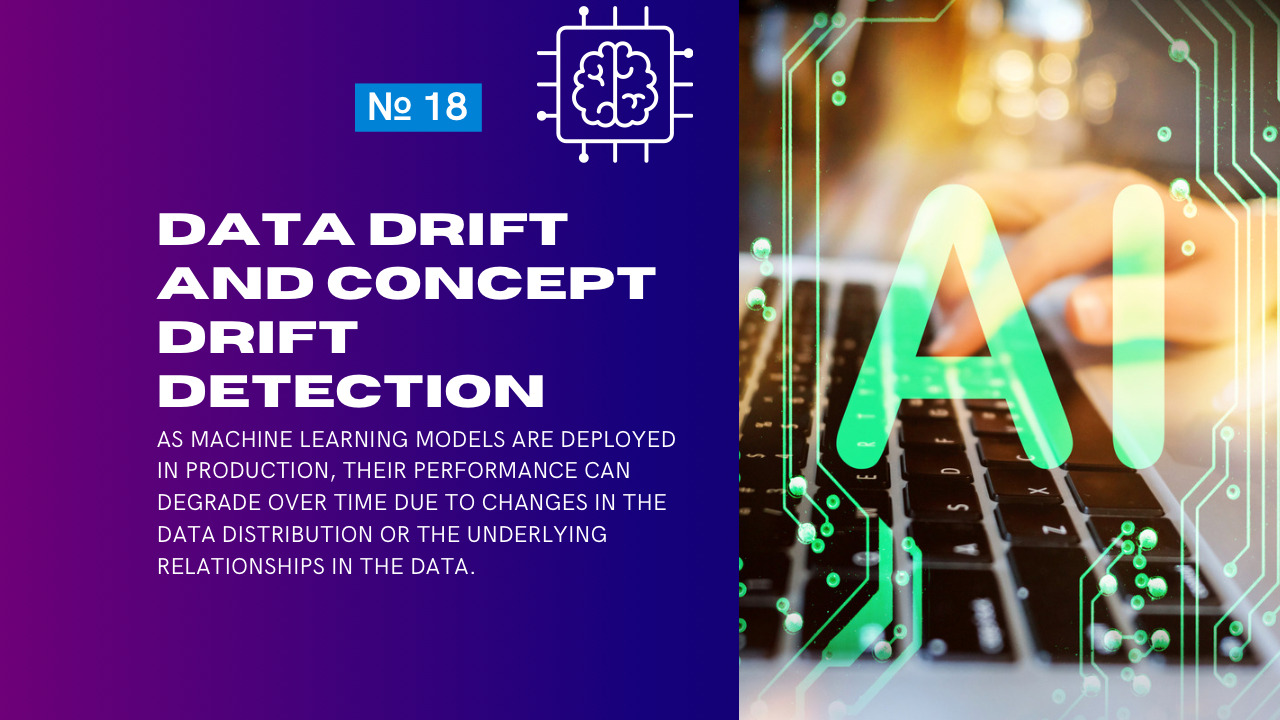As machine learning models are deployed in production, their performance can degrade over time due to changes in the data distribution or the underlying relationships in the data. This phenomenon is referred to as data drift and concept drift.
Effective monitoring and detection of these drifts are crucial to maintaining model performance, reliability, and fairness. Tools like Alibi Detect are designed to address these challenges by providing robust drift detection capabilities.
What Are Data Drift and Concept Drift?
- Data Drift:
- Occurs when the distribution of input features changes over time.
- Example: A model trained on customer behavior data from one season might perform poorly during another season due to shifting preferences.
- Concept Drift:
- Happens when the relationship between input features and target variables changes.
- Example: A credit scoring model might underperform if the factors influencing loan defaults change over time (e.g., due to economic shifts).
Why Detect Drift?
- Maintain Model Performance:
- Identify and address degradation early to avoid poor predictions in production.
- Trigger Model Retraining:
- Automate retraining workflows when significant drift is detected.
- Ensure Fairness:
- Monitor for biases or changes in sensitive attributes.
Tools for Drift Detection
1. Alibi Detect
Alibi Detect is an open-source Python library specifically designed for drift detection, outlier detection, and adversarial detection in machine learning pipelines.
Features:
- Supports both data drift and concept drift detection.
- Offers multiple statistical and model-based drift detection methods.
- Flexible integration with existing ML pipelines.
Drift Detection Techniques in Alibi Detect:
- Statistical Tests:
- Kolmogorov-Smirnov Test, Chi-Square Test, etc.
- Suitable for numerical and categorical data.
- Embedding-Based Methods:
- Learn representations of data using models like autoencoders or pre-trained embeddings.
- Detect drift in latent spaces.
- Classifier-Based Methods:
- Train a classifier to distinguish between old (reference) and new data. If the classifier performs well, data drift is likely.
2. Evidently
Evidently is another open-source library focused on monitoring and visualizing data drift and concept drift.
Features:
- Generates detailed reports for drift analysis.
- Monitors feature distributions over time.
- Easily integrates with CI/CD workflows for continuous monitoring.
3. TensorFlow Data Validation (TFDV)
TFDV is part of TensorFlow Extended (TFX) and provides tools for analyzing and validating data.
Features:
- Automatically detects data schema anomalies.
- Monitors feature statistics over time.
- Designed for TensorFlow-based pipelines.
How Alibi Detect Works
1. Installing Alibi Detect
Install the library using pip:
pip install alibi-detect2. Drift Detection Example
Below is an example of using Alibi Detect to detect data drift in numerical data:
import numpy as np
from alibi_detect.cd import KSDrift
# Generate reference data (old data) and test data (new data)
np.random.seed(0)
reference_data = np.random.normal(0, 1, (1000, 5)) # Reference data
test_data = np.random.normal(1, 1, (1000, 5)) # Test data with drift
# Initialize drift detector (Kolmogorov-Smirnov test)
cd = KSDrift(p_val=0.05)
# Fit the detector to reference data
cd.fit(reference_data)
# Detect drift
predictions = cd.predict(test_data)
print(f"Drift detected: {predictions['data']['is_drift']}")Key Steps:
- Fit the Detector:
- Use the reference dataset to initialize the detector.
- Detect Drift:
- Pass the new dataset to
cd.predict()to check for drift.
- Interpret Results:
is_drift = 1indicates drift, whileis_drift = 0means no drift.
3. Concept Drift Detection Example
To detect concept drift, you can train a classifier to distinguish between the reference and test data:
from alibi_detect.cd import ClassifierDrift
from sklearn.ensemble import RandomForestClassifier
# Initialize classifier
model = RandomForestClassifier()
# Initialize concept drift detector
cd = ClassifierDrift(model, threshold=0.5)
# Fit on reference data
cd.fit(reference_data)
# Detect drift
predictions = cd.predict(test_data)
print(f"Concept drift detected: {predictions['data']['is_drift']}")Comparison of Tools
| Tool | Best For | Key Features | Limitations |
|---|---|---|---|
| Alibi Detect | Advanced drift detection techniques. | Statistical, embedding-based, and classifier-based methods. | Requires Python-based pipelines. |
| Evidently | Monitoring and visualization. | Automated dashboards and reporting. | Limited advanced drift detection methods. |
| TFDV | TensorFlow pipelines. | Schema validation and feature statistics. | Focused on TensorFlow ecosystem. |
Best Practices for Drift Detection
- Choose the Right Metric:
- Use statistical methods for simpler datasets.
- Use embedding-based methods for high-dimensional data.
- Monitor Key Features:
- Focus on features critical to model predictions.
- Integrate Drift Detection into Pipelines:
- Combine tools like Alibi Detect with CI/CD workflows for real-time monitoring.
- Set Drift Thresholds:
- Define acceptable levels of drift to avoid false positives.
- Automate Retraining:
- Trigger model retraining automatically when significant drift is detected.
Conclusion
- Alibi Detect is a powerful tool for detecting both data drift and concept drift, offering flexibility and scalability for modern ML pipelines.
- Use tools like Evidently for visualizing drift and TFDV for TensorFlow-specific pipelines.
- By implementing drift detection, you can ensure that your models remain robust and reliable in dynamic production environments.
